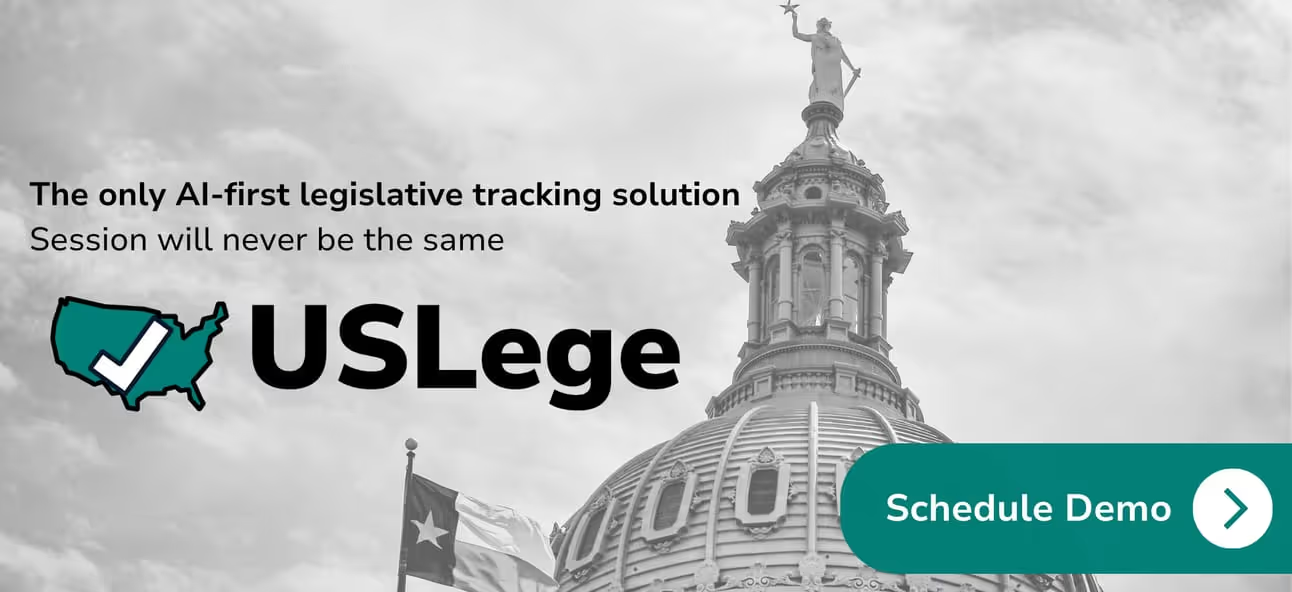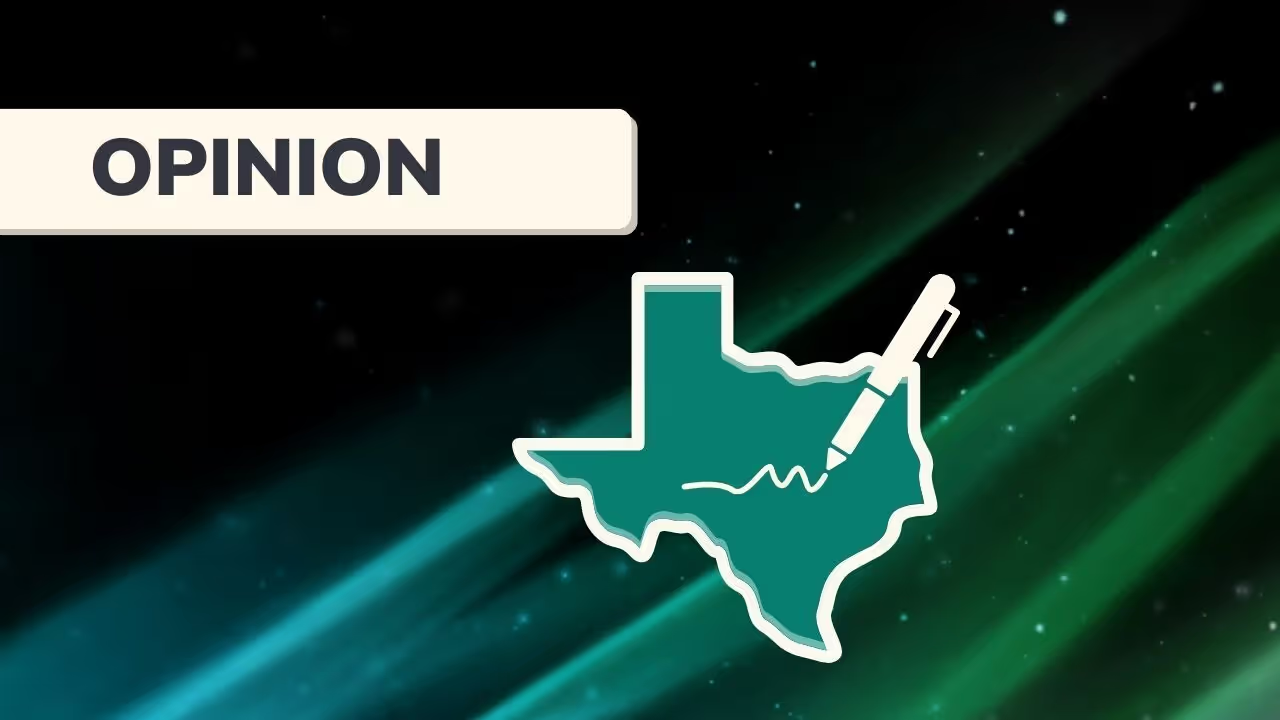
Welcome to Friday Forum, a weekly segment where we explore diverse opinions on the topics shaping Texas politics and business. The views expressed here represent the perspectives of individual contributors and are not endorsements by TXLege News. Our aim is to encourage thoughtful discussion and present a range of viewpoints on issues that matter to Texans. Email info@uslege.ai for submitting opinion contributions.
The Debate
The debate about school choice is over. What matters most now is the integrity of the education savings accounts (ESAs) program that the legislature will create during the 89th session.
The debate is over for three essential reasons. First, the governor, lieutenant governor and speaker all support school choice. In 2024, Governor Greg Abbott spearheaded a fierce political campaign to unseat House Republicans who torpedoed ESAs in November 2023 during the fourth special session. The new class of Republicans features some amazingly talented people – Katrina Pierson, Hillary Hickland, Joann Shofner, Janis Holt, Shelly Luther, Brent Money and Marc LaHood to name a few – who campaigned on school choice and will help lead passage of the bill.
Lt. Governor Dan Patrick has been a stalwart on the issue for years. As a senator in 2013, he authored SB 23 to create a school choice program and successfully passed the bill out of the Education Committee. Since then, the Texas Senate has passed no less than six bills to empower parents with educational choices, including several universal ESA bills. Dan Patrick is chiefly responsible for those victories.
Speaker Burrows voted for ESAs at least three times in 2023, twice supporting Chairman Brad Buckley’s work on an ESA bill and opposing former Rep. Abel Herrero’s decade-long budget amendment to prohibit funding for any type of school choice program.
Second, President Trump is solidly for school choice. Any Republican who opposes school choice now risks the ire of the President, who has made it de rigueur to expose wayward Republicans on social media and recruit candidates in primaries. Relatedly, every right-of-center think tank that engages in education policy supports school choice led by TPPF and TCCRI and Families Empowered in Texas; AFC, Yes Every Kid, EdChoice and Heritage Foundation nationally. There’s no daylight between President Trump and these organizations on the issue of school choice.
Third, the respective education committee chairmen, Sen. Brandon Creighton and Rep. Buckley, have done the spadework with their colleagues to establish credibility for an ESA bill. In 2023, Chairman Creighton passed out of the Senate a universal ESA bill three times. At the same time, Chairman Buckley sponsored SB 8, a parent’s bill of rights which included an ESA, and authored a nearly universal ESA, but neither was enacted.
The political debate is done.
Now, the legislature must fashion a bill that learns from best (and worst) practices in other states. A sound ESA plan would include several key provisions.
1. Universal eligibility with appropriations mechanisms to fund demand. Like the public school system that will accept any student, the ESA program should not exclude any school-aged child. While appropriations will ultimately cap how many children can enter the program in the first year, every child should be eligible. In future years, the program should fully fund an ESA for every eligible applicant. This will avoid the current situation in Texas public charter schools, where 76,000 children sit on waitlists as their parents seek, but are denied, educational opportunity. As a parallel, Florida has more than 500,000 students in its ESA and has 3.8 million school-age children. Because Texas has 6.4 million school-age children, we expect our ESA student population to quickly eclipse Florida’s.
2. A payment system that is trusted, ubiquitous, fast, and secure. Other states have online plus out-of-pocket systems using a single online web portal through which parents purchase educational expenses from approved vendors. However, a state-approved web portal cannot include all approved expenses from all approved vendors, which leads to a stop-gap solution in which states encourage parents to pay out-of-pocket for approved educational expenses and then seek reimbursement. As Arizona shows, this is a mistake that has caused transactions to take months to process. Texas can do better by designing a payment system that should meet four criteria:
- Allow parents to conveniently pay providers for educational expenses
- Complete transactions almost instantaneously
- Maintain privacy, and
- Prevent fraud and theft.
If these criteria are met, a Texas ESA will earn the trust of parents and schools. A model already exists in Health Savings Accounts (HSAs).
3. Support for parents is essential. Marketing research from other states shows there is a remarkable lack of awareness about ESAs: 46% of parents in Florida and Arizona are not aware of their state’s ESA program despite Arizona’s launching in 2011 and Florida’s in 2019. The Texas program should support participating parents:
- Select a provider chosen by the parent
- Complete an application for a provider such as a school
- Manage a student account, including payment planning
- Comply with program requirements, including deadlines, and
- Appeal a program decision.
4. Protect religious liberties and guard against regulation of families and schools. This could be achieved by making the program entirely opt-in for both students and providers and holding the money in an account for the benefit of the student and not a provider or vendor. The law should also clearly protect educational creeds, practices, admissions policies, curricula, performance standards, and employment policies. The only substantial requirement would be for program participants to take a nationally norm-referenced test or the STAAR exam to track performance.
5. Allow public institutions to serve ESA students. One of the least known provisions of the 2023 ESA bills was that any accredited public or private school could serve ESA students. This would allow visionary public school leaders to serve key groups that they know need support, including pre-kindergarten children or students who are especially vulnerable to summer slide. They could also offer programs of study to homeschooled high school students - and this is only the beginning.
The Covid-19 pandemic was eye-opening for many parents, with 60% reporting that their educational preferences and expectations changed and 80% now saying that their child’s learning could and should happen anywhere. Remarkably, half (48%) of parents are interested in new or different learning pathways. As a result, ESAs expanded rapidly. In the 2018-19 school year, just under 20,000 children participated in ESAs. Preliminary data for the 2024-25 school year shows that there are currently about 860,000 ESA students.
Texas families want educational opportunity, and they elected lawmakers who will deliver it.
John Colyandro and Michael Barba
Colyandro Public Affairs
John Colyandro served as Senior Advisor and Policy Director for Gov. Greg Abbott and his policy director on three statewide campaigns. Colyandro also served as Director of the Texas Conservative Coalition, a legislative caucus. Barba most recently served as the Policy Director of K-12 Education at the Texas Public Policy Foundation. Prior to this, he served as a specialist on the System of Great Schools (SGS) team at the Texas Education Agency.
We hope you enjoyed today’s read!
🎙️We Have a Podcast! 🎙️
Bills and Business is your go-to podcast for conversations related to Texas legislation and business. Hosted by Laura Carr, Co-Founder of USLege—an AI-driven legislative tracking software—we bring you in-depth analysis on economic trends, impactful legislation, and key developments shaping Texas business.
Subscribe on Youtube and Spotify for weekly episodes!

- 01 First
Subscribe to our Newsletter

Read more news

How to Choose the Best Legislative Tracking Software for Your Organization
In today’s fast-paced policy environment, staying informed is a constant challenge. Bills, hearings, and regulatory updates move quickly across jurisdictions, creating risks for organizations that rely on timely information, including the risk of missing important information when relying on manual processes. Choosing the best legislative tracking software is one of the most effective ways to manage legislative and regulatory tracking efficiently, minimize missed opportunities, and strengthen decision-making.
This article walks you through how to evaluate legislative and regulatory tools, compare coverage and capabilities, and understand which features help government affairs professionals and public affairs teams stay informed and a step ahead of rapid change. You’ll learn how to assess software platforms, review vendor performance, and apply a clear framework to guide your organization’s choice.
If you’re exploring modern solutions for policy monitoring, visit the best legislative tracking software to see how advanced systems help professionals track activity and analyze critical information across multiple jurisdictions.
Why Legislative Tracking Software Matters
Every legislative session brings thousands of new bills and hearings across the federal government, state legislatures, and local governments. For government affairs teams and law firms that must monitor state legislation or track regulations, the pace of change can be overwhelming.
Without digital platforms, staff may spend hours each day manually searching databases, reading committee reports, and updating spreadsheets. That process isn’t just inefficient—it’s risky. Missing one act or amendment could affect compliance, advocacy strategy, or even public reputation. Relying on manual tracking increases the chance of overlooking important details in legislative information, which can lead to missing critical updates or changes.
The Challenge of Volume and Velocity
- Legislative and regulatory tracking spans bills, hearings, amendments, and regulations that appear daily.
- Strategic decisions depend on access to verified data and real-time alerts.
- Regulatory developments from government agencies can impact clients and advocacy groups instantly.
The Payoff
Automated tracking saves time, reduces human error, and delivers actionable insights faster. Teams can filter results, share updates, and focus their attention where it matters most—on influencing policy and shaping outcomes.
Key Features and Capabilities to Look For
Choosing the right tracking platform starts with understanding what differentiates effective tools from simple alert systems. Below are core features to evaluate before purchasing or implementing any solution.
Coverage Across Jurisdictions
The best systems provide a broad jurisdictional reach—from federal legislation to state legislative hearings and local government acts. Before committing, confirm whether the platform includes:
- Federal and state legislation: Bills, amendments, regulations, hearings, and newly introduced bills, with Congress as a key source for federal legislative tracking.
- Regulatory activity: Notices from agencies and committees.
- Comprehensive data sources: Congressional records, local archives, and state portals.
Understanding the dynamic nature of Capitol Hill is crucial, as legislative activity and staff turnover at the federal level can significantly impact advocacy strategies and tracking efforts.
If your team must monitor state legislation, check that the vendor’s coverage includes smaller states and municipalities that frequently pass niche regulations.
Real Time Alerts and Notifications
Fast updates are critical for professionals who manage compliance or advocacy campaigns. Strong systems offer:
- Instant email alerts for bill introductions, amendments, or new hearings.
- Custom filters for topics, sponsors, committees, or jurisdictions.
- Real-time dashboards showing where legislation is moving next.
- Collaboration tools so teams can assign follow-up actions or comments.
With real-time alerts, government affairs professionals and policy experts can respond before deadlines pass—ensuring that organizations stay ahead and fully informed.
Analytics, Reporting, and Insight Generation
Good tracking isn’t just about collecting raw data. It’s about turning that data into useful analysis. A well-built platform helps users:
- Create trend dashboards showing activity by topic, legislator, or region.
- Generate reports to brief clients, executives, or advocacy groups.
- Use artificial intelligence to compare bills, predict movement, or analyze outcomes.
- Access historical data for longitudinal analysis.
By combining analytics with visualization tools, organizations gain the context needed to make strategic decisions quickly.
Artificial Intelligence in Legislative Tracking
Artificial intelligence transforms how government affairs professionals and government relations teams approach legislative tracking. By harnessing AI, organizations can analyze massive volumes of legislative and regulatory data in real time, ensuring that no critical bill or regulation goes unnoticed. AI-powered tools can automatically identify and prioritize bills that align with an organization’s advocacy goals, generate personalized bill summaries, and even predict the likelihood of legislative movement—all with minimal manual intervention.
For government relations professionals, this means less time spent sifting through raw data and more time focusing on strategy, stakeholder engagement, and influencing policy outcomes. AI-driven platforms can scan every legislative chamber, flagging new bills and regulations that matter most to your organization. These actionable insights empower teams to stay ahead of policy developments, respond quickly to emerging issues, and confidently make strategic decisions. As artificial intelligence continues to evolve, it will play an increasingly vital role in helping professionals track legislation, analyze regulatory trends, and drive effective advocacy across all levels of government.
Ease of Use and Vendor Support
Complex systems often fail because users find them hard to operate. When evaluating tracking software, consider:
- Intuitive search functions and clear navigation.
- Vendor training, documentation, and help-desk responsiveness.
- Implementation timelines and onboarding resources.
- Integration options with CRM, compliance, or reporting platforms.
The easier the interface, the more likely professionals across departments—legal, advocacy, and communications—will actually use it.
Security and Data Protection
When it comes to legislative tracking, security and data protection are non-negotiable for government affairs professionals and organizations. The sensitive nature of legislative and regulatory data—combined with the need for accurate, up-to-date information—means that robust security measures are essential. Leading legislative tracking platforms employ advanced encryption, secure servers, and strict access controls to ensure that only authorized users can access critical information.
In addition, reputable platforms adhere to industry best practices and compliance standards, safeguarding client data from unauthorized access or breaches. This commitment to security allows government relations professionals to focus on their core strategy and advocacy efforts, knowing that their data is protected at every step. By selecting a platform with proven security protocols, organizations can confidently manage their legislative tracking activities and maintain the trust of stakeholders, clients, and team members.
Integration with Other Tools
For government affairs professionals, efficiency and collaboration are key to successful advocacy. That’s why seamless integration between legislative tracking platforms and other essential tools—such as CRM systems, email clients, and social media monitoring software—is so valuable. Integrated platforms enable government relations professionals to track bills, monitor legislator interactions, and analyze advocacy campaigns all in one place, reducing manual data entry and streamlining workflows.
By connecting legislative tracking with CRM systems, organizations can maintain a comprehensive record of stakeholder engagement, track the progress of key bills, and measure the impact of their advocacy efforts. Integration with communication tools also ensures that teams can quickly share updates, assign tasks, and coordinate responses to legislative developments. Ultimately, these integrations help government affairs teams stay ahead of policy changes, maximize efficiency, and deliver more effective results for their organizations and clients.
Cost, Scalability, and ROI
Pricing varies widely across platforms. Some charge by user, others by jurisdiction. Evaluate:
- Scalability: Can you expand access as new teams join?
- Hidden costs: Extra fees for integrations or data exports.
- ROI: Measure efficiency gains, reduced research hours, and improved regulatory compliance.
The right investment pays for itself through faster tracking, stronger insight, and better policy outcomes.
Building Your Decision-Making Checklist
A structured checklist helps teams evaluate multiple vendors objectively. Consider the following steps:
- Define scope: Identify which government levels—federal, state, local—your organization must monitor.
- Map stakeholders: Determine which departments, clients, professionals, or legislators need access to legislative tracking information.
- Create a scoring system: Rate vendors on coverage, alerts, analytics, ease of use, and cost.
- Request demos: Ask vendors to show how their tools track legislation and deliver reports.
- Review accuracy: Compare automated alerts to official legislative portals to confirm reliability.
- Pilot the system: Run a short test during a legislative session to evaluate performance.
This structured review allows government relations professionals and policy experts to make choices based on measurable evidence, not sales claims.
Common Pitfalls and How to Avoid Them
Even sophisticated organizations can stumble during implementation. Watch for these frequent errors:
- Assuming full coverage: Some systems exclude local governments or agency regulations. This can result in missing important government actions, leaving you unaware of key legislative or regulatory developments.
- Overloading users: Too many irrelevant alerts lead to fatigue.
- Ignoring integration: Platforms that don’t connect to existing tools reduce efficiency.
- Underestimating training: Teams may resist new systems without clear onboarding.
- Skipping metrics: Without KPIs, you can’t analyze ROI or improvement.
Avoiding these issues keeps your strategy grounded in real performance data.
Implementation Best Practices and Maximizing Value
Rolling out a new tracking platform works best when everyone understands the process. Follow these steps:
- Stakeholder alignment: Engage government affairs, legal, and communications teams early.
- Define taxonomy: Standardize issue tags, committees, and jurisdiction names.
- Workflow mapping: Assign ownership for monitoring, escalation, and communication.
- Training: Offer live sessions and short guides to reinforce adoption.
- Continuous review: Revisit settings each quarter to refine alerts and search filters.
As policy cycles shift, ongoing optimization ensures that your system remains accurate, relevant, and responsive to regulatory developments.
For additional insight on how legislative and regulatory tools operate, review the NCSL’s bill tracking overview, which explains how professionals track state legislation effectively.
Future of Legislative Tracking
The future of legislative tracking is bright, with rapid advancements in artificial intelligence, machine learning, and data analytics reshaping how government affairs professionals and organizations monitor and influence policy. As the demand for real-time, data-driven insights grows, legislative tracking tools will become even more sophisticated—offering predictive analytics, automated reporting, and deeper integration with other advocacy platforms.
We can expect to see greater adoption of cloud-based solutions, enhanced security features, and more intuitive user interfaces that make it easier for government relations professionals to access and analyze critical information. The integration of legislative tracking with CRM, communication, and analytics tools will provide a unified view of advocacy efforts, enabling teams to coordinate strategy and engage stakeholders more effectively.
As the policy landscape evolves, staying ahead of legislative and regulatory developments will be essential for organizations seeking to influence legislation and achieve their advocacy goals. By embracing the latest technologies and innovations, government affairs professionals can ensure they remain agile, informed, and ready to drive meaningful impact in an ever-changing environment.
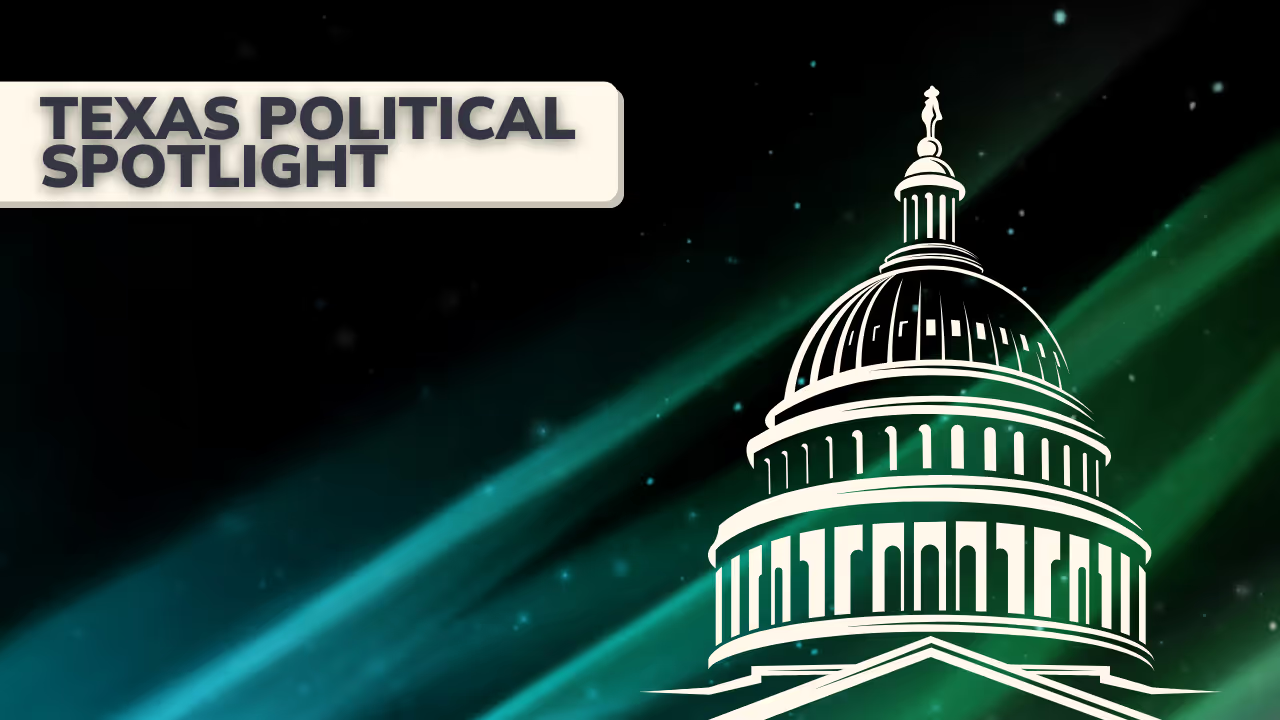
Texas Political Spotlight
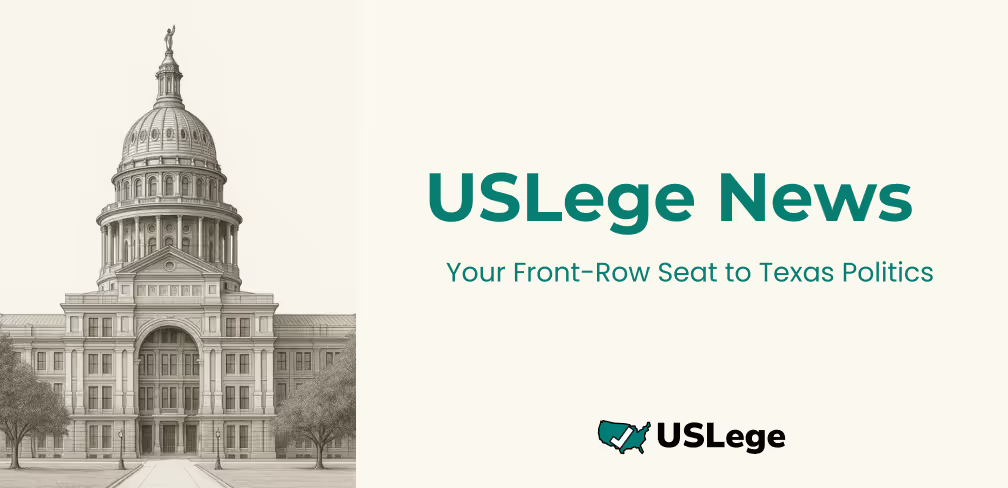
Welcome back, friends
Texas voters approved one of the largest property tax relief packages in state history on Tuesday, raising the homestead exemption to $140,000 and granting new tax breaks for seniors, people with disabilities, and small businesses. In Austin, residents rejected Proposition Q, a plan to fund public safety, homelessness programs, and city facility initiatives through a property tax hike, forcing city leaders to rework the budget and brace for service cuts. Meanwhile, Bexar County voters narrowly passed Propositions A and B, greenlighting up to $311 million in tourism-funded support for a new downtown Spurs arena and upgrades to the Freeman Coliseum grounds.
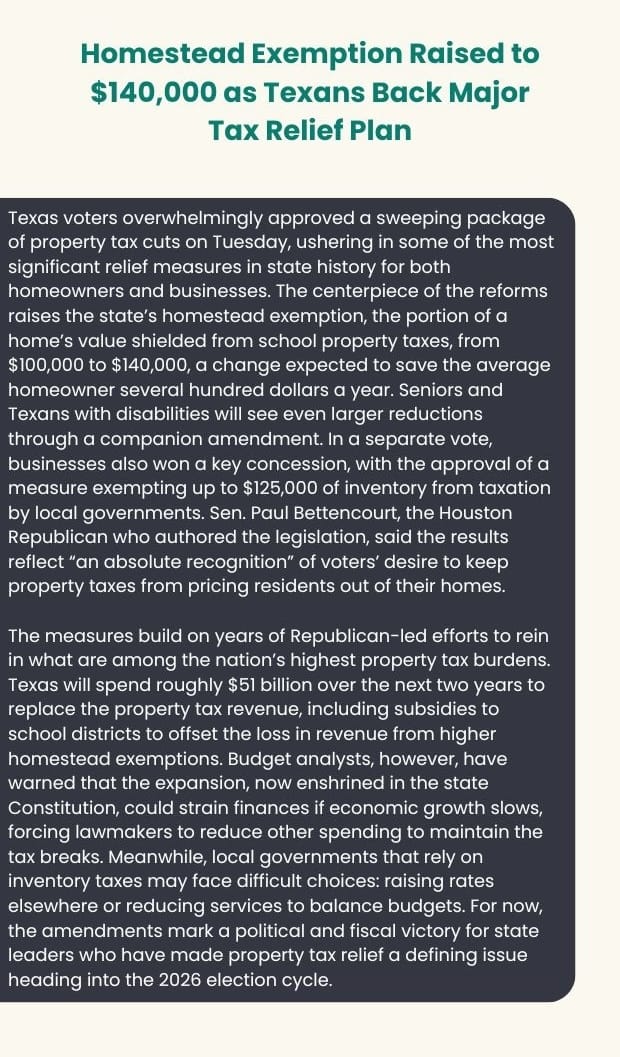
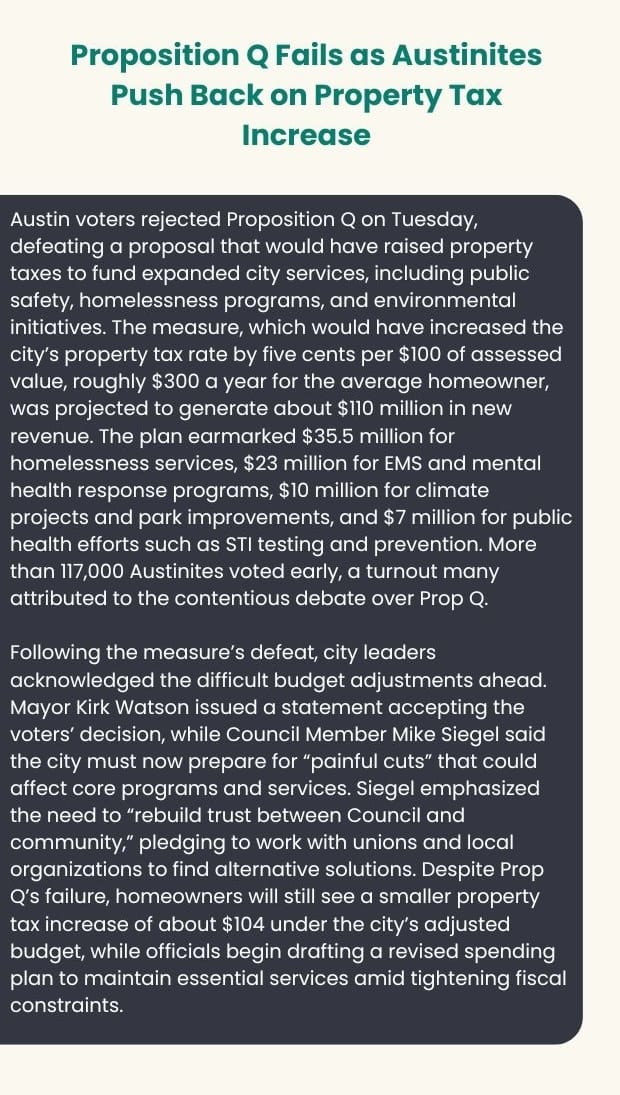
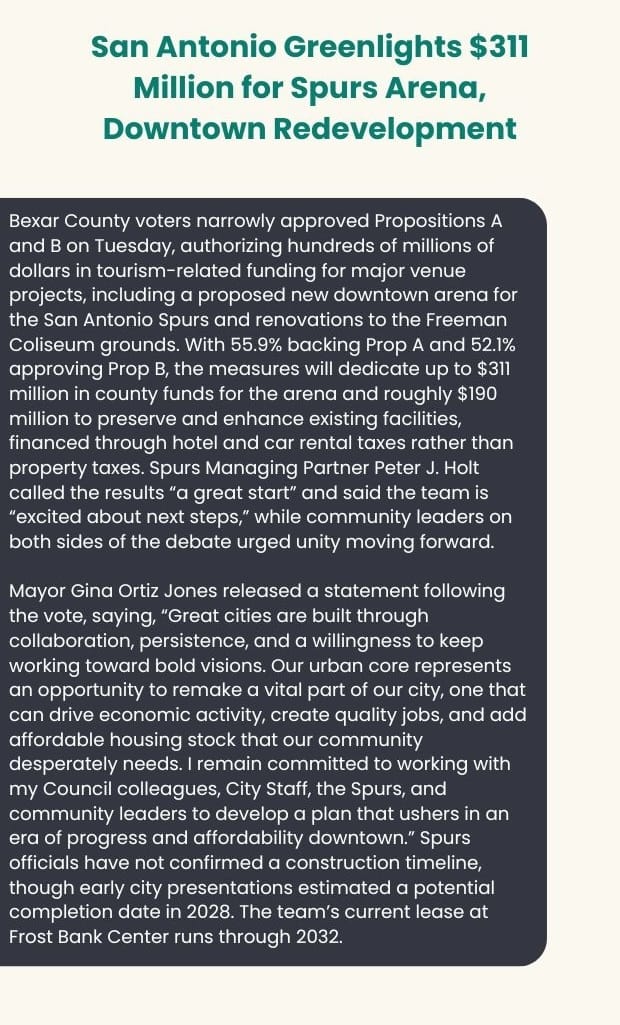
We hope you enjoyed today’s read!

Texas Political Spotlight

Welcome back friends,
Former Vice President Dick Cheney, one of the most influential and controversial figures in modern American politics, has died at 84, remembered by former President George W. Bush as a “patriot” whose intellect and conviction shaped decades of U.S. policy. In Texas, the Education Agency announced a sweeping takeover of Fort Worth ISD, the state’s second-largest intervention, citing years of academic underperformance and plans to install new local managers. And in Washington, a United Airlines flight was evacuated after a bomb threat, prompting an FBI investigation that later found no explosives, allowing operations to resume safely.

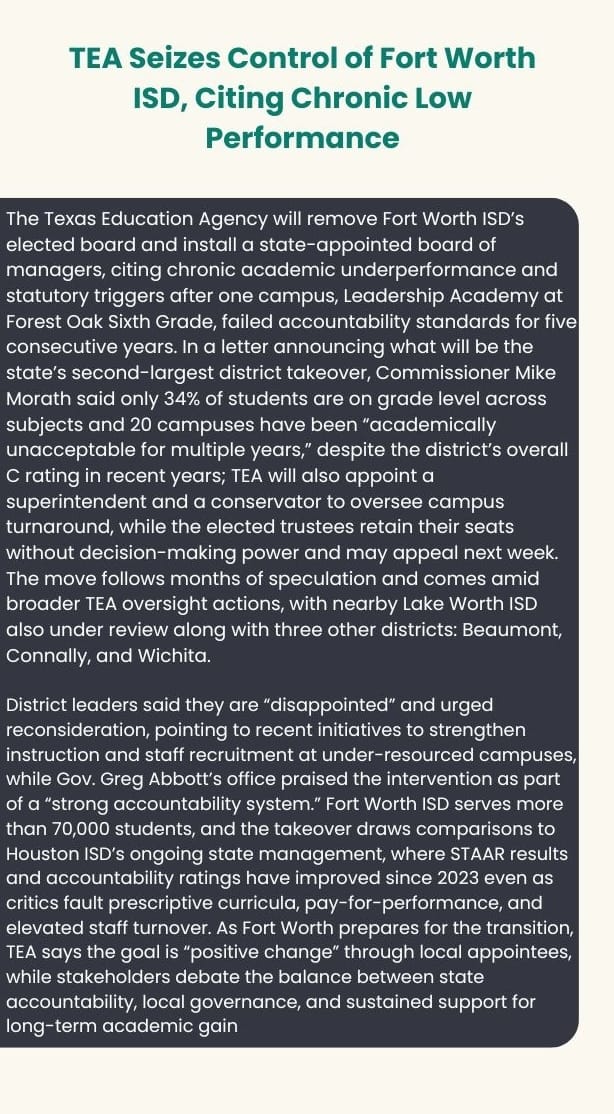

We hope you enjoyed today’s read!



